When launched, PowerPoint 365 for Windows typically opens with
Backstage View. If you want to create a new
presentation, you can do so using the New tab. If you
want to work on any of the already created presentations you can open them by using the various options in the Open tab.
In this tutorial, we explore two of those tabs (see Figure 1):

Figure 1: Open and Close options
Open
Follow these steps to open an existing file on your computer in PowerPoint 365 for Windows:
- Launch PowerPoint 365 for Windows and click the File menu, as shown highlighted in
red within Figure 2.

Figure 2: File menu- This action opens Backstage View.
Select the Open tab as shown in Figure 3.
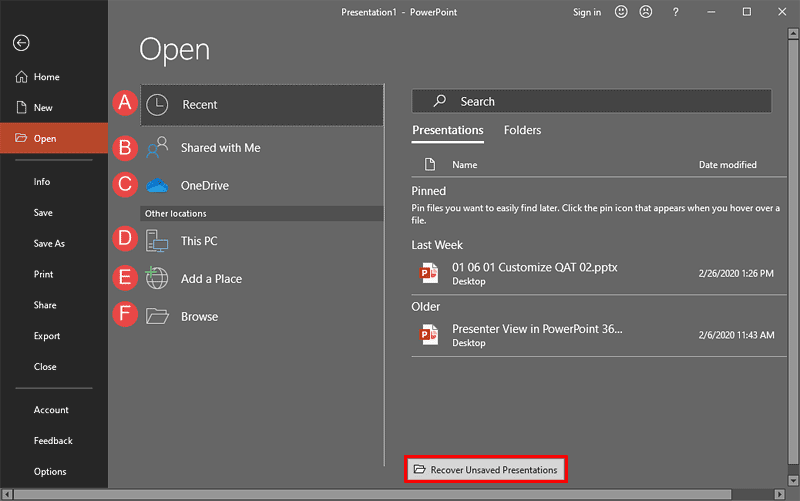
Figure 3: Open tab selected within Backstage view- Options within the Open tab are explained below, as marked in Figure 3, above:
A. Recent
- In this section, you'll find two tabs. The Presentations tab is where you can find a list of your recently
accessed presentations. Similarly, the Folders tab shows a list of recently accessed folders. Both of these tabs provide options to
pin your files and folders. The pinned content shows up right on top. To pin a presentation or folder, just hover your cursor over any file or folder
within the Presentations or the Folders tab, and click the Pin this item to the list icon, as shown
highlighted in red within Figure 4, below. It's a good idea to pin your most frequently used files and
folders so that you can access them quickly.

Figure 4: Pin this item to the list icon- Atop both these tabs, you'll also find the Search bar, highlighted in blue
within Figure 4, above. Just type in a file name or even part of a file name. Results will look through your recent files and
folders, and also files shared with you on cloud locations.
- Within the Recent section, you will also find the Recover Unsaved Presentations button, as shown
highlighted in red within Figure 3, shown previously on this page. Click this option, and PowerPoint
will try to recover unsaved presentations that may have been lost to unexpected PowerPoint or computer crashes.
B. Shared with Me
- In this tab, you'll find a list of online documents that are shared with you which you want to open. You need to sign in
to your Microsoft account within PowerPoint to see this list.
In Figure 5, below you can see an empty list since we are not signed in.
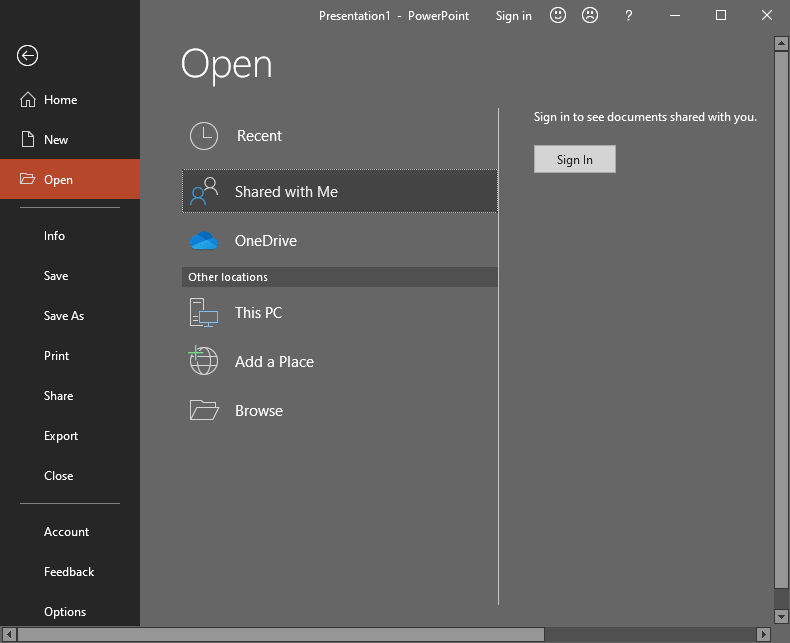
Figure 5: Shared with MeC. OneDrive
- Within this tab, you'll find a list of online files stored on your
OneDrive. To view and open these files, you need to sign in to your OneDrive account
from within PowerPoint or any other Microsoft Office 365program. Figure 6, below shows the Sign In button.
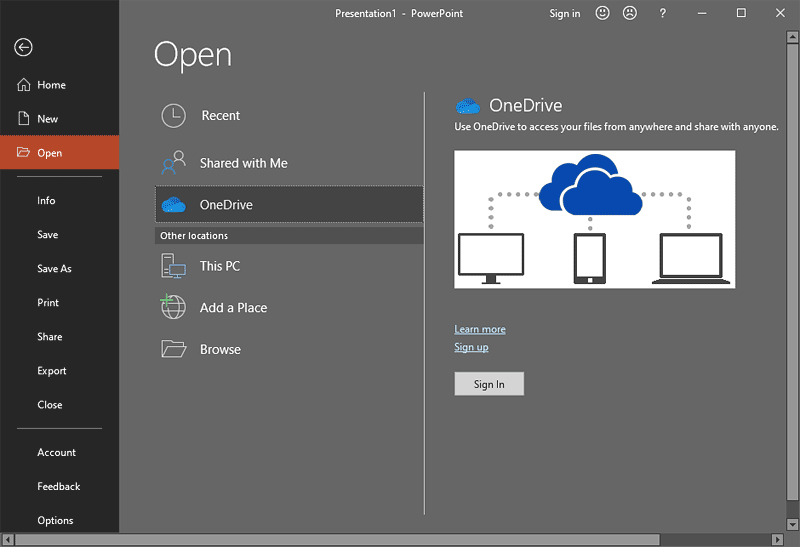
Figure 6: OneDriveD. This PC
- This tab lets you explore files and folders from your local system. You just access the folder where your file is
saved, select the file and open it. In Figure 7, you can see a list of folders from where we could open a file.
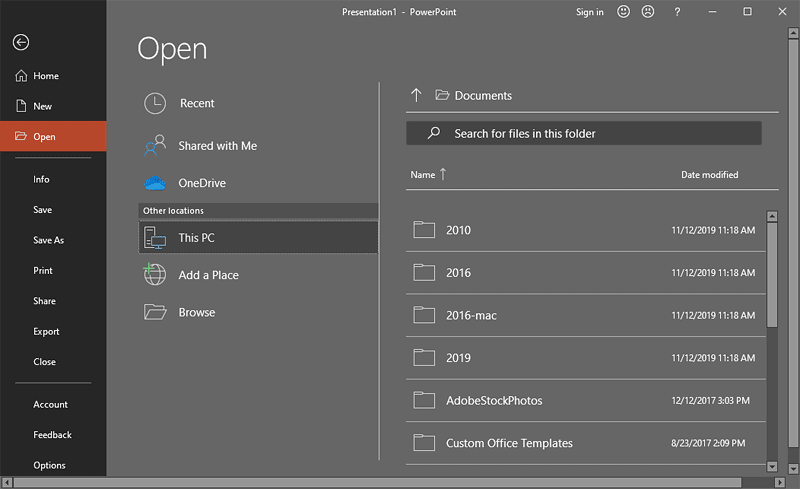
Figure 7: This PCE. Add a Place
- You can also choose the Add a Place option, as shown in Figure 8. You can choose
to add multiple OneDrive and OneDrive for Business accounts. These added accounts will show up as multiple places within the Open
tab of Backstage view. Learn more in our Add a Place
tutorial.
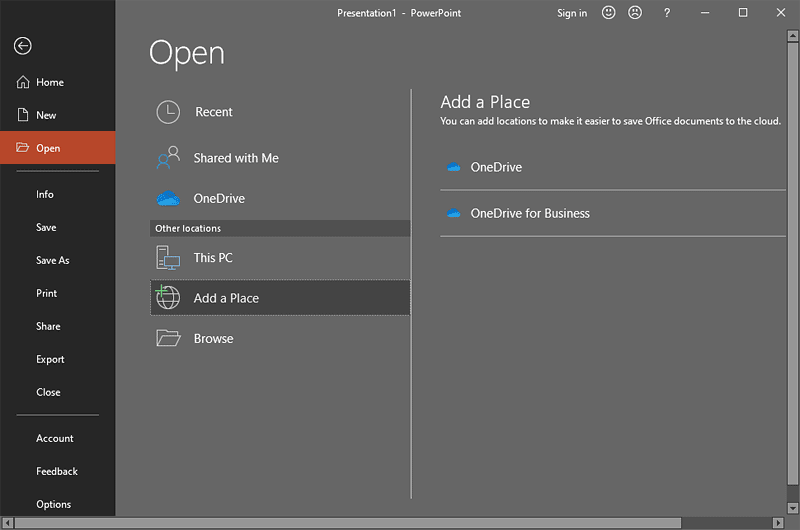
Figure 8: Add a PlaceF. Browse
- To open a presentation in an old-fashioned way, click the Browse option.
This brings up the Open dialog box, as shown in Figure 9. Navigate to wherever your presentation files are saved,
and you can open any of them. You'll find that PowerPoint can open
files of various formats (types).
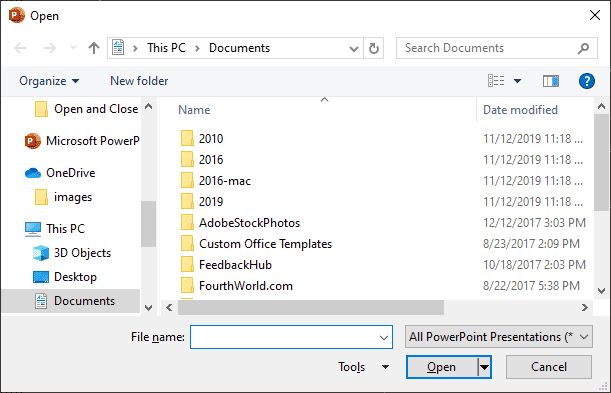
Figure 9: Open dialog box- Select the presentation or file you want to open, and then click the Open button. Remember that
the Open button has a down-arrow next to it. Clicking this down-arrow provides more Open options
(see Figure 10). Choose any of them; an explanation of these options follows.

Figure 10: Open options- Here's a brief explanation of these options:
- Open, the default option is the same as clicking the Open button.
- Open Read-Only lets you open a read-only copy of the presentation. This is great if you don't want to make some
changes and overwrite the original presentation.
- Open as Copy lets you open a copy of the presentation, almost like creating a new presentation while leaving the
original unaltered.
- Open in Browser works only with certain file formats, such as MHT. See
file formats PowerPoint can open.
- Open in Protected View lets you open a presentation with restrictions to protect damage to your computer. You can
open potentially dangerous files, such as those downloaded from an unknown source on the Internet in the Protected View.
- Open and Repair allows PowerPoint to attempt repair of a file that is possibly corrupt.
Back
Close
The Close option, highlighted in red within Figure 11 is used to
close the active presentation. PowerPoint prompts you to save any unsaved changes.

Figure 11: The Close option
Back














